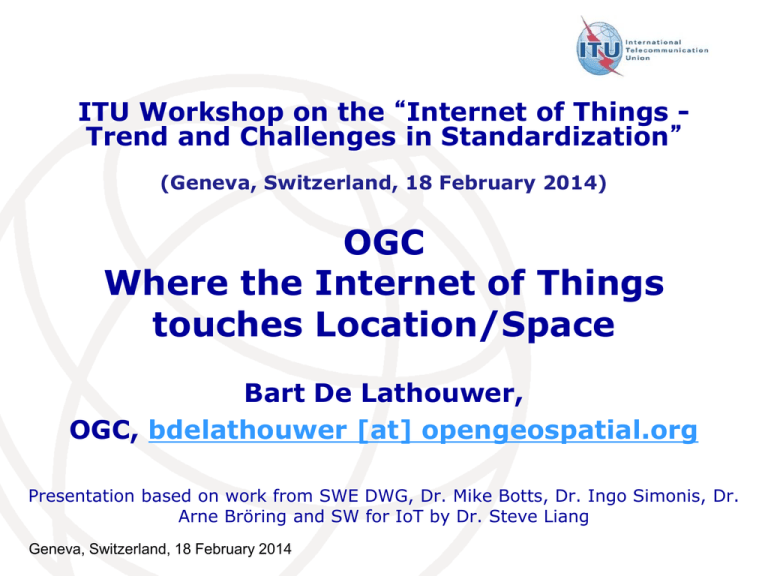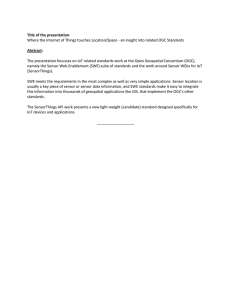OGC Where the Internet of Things touches Location/Space ITU Workshop on the
advertisement

ITU Workshop on the “Internet of Things Trend and Challenges in Standardization” (Geneva, Switzerland, 18 February 2014) OGC Where the Internet of Things touches Location/Space Bart De Lathouwer, OGC, bdelathouwer [at] opengeospatial.org Presentation based on work from SWE DWG, Dr. Mike Botts, Dr. Ingo Simonis, Dr. Arne Bröring and SW for IoT by Dr. Steve Liang Geneva, Switzerland, 18 February 2014 Topics OGC Introduction IoT touches Location/Space SWE SWE for IoT Conclusions and Recommendations © 2012 Open Geospatial Consortium The Open Geospatial Consortium Not-for-profit, international voluntary consensus standards organization; leading development of geospatial standards • Founded in 1994. • 480+ members and growing University 24% • 33 “core” standards • 15 extensions/profiles • Hundreds of product implementations • Alliances and collaborative activities with ISO and many other SDO’s Copyright © 2014 Open Geospatial Consortium Commercial 41% Research 7% NGO 10% Government 18% 3 4 Sensor Web Desires Quickly discover sensors and sensor data (secure or public) that can meet my needs – location, observables, quality, ability to task Obtain sensor information in a standard encoding that is understandable by me and my software Readily access sensor observations in a common manner, and in a form specific to my needs Sensor Web Desires II Task sensors, when possible, to meet my specific needs Subscribe to and receive alerts when a sensor measures a particular phenomenon Sensor Web Vision I Sensors will be web accessible Sensors and sensor data will be discoverable Sensors will be self-describing to humans and software (using a standard encoding) Most sensor observations will be easily accessible in real time over the web Sensor Web Vision II Standardized web services will exist for accessing sensor information and sensor observations Sensor systems will be capable of realtime mining of observations to find phenomena of immediate interest Sensor systems will be capable of issuing alerts based on observations, as well as be able to respond to alerts issued by other sensors Sensor Web Vision III Software will be capable of on-demand geolocation and processing of observations from a newly-discovered sensor without a priori knowledge of that sensor system Sensors, simulations, and models will be capable of being configured and tasked through standard, common web interfaces Sensors and sensor networks will be able to act on their own (i.e. be autonomous) Building Blocks: OGC SWE Services Observation SOS Tasking SPS Alerting SAS WNS Analysis Registries & Dictionaries Sensor Phenomenon CS-W Description SensorML O&M Description Language Language SWE SensorsSensorML Register Publish Register CAT Register SOS Search DB O&M Bind SOS SOS SWE SensorsSensorML Register Register CAT SOS Task Search 1 SPS 3 Notify WNS 6 5 GetResults 2 O&M Task 4 notification SOS SPS SWE SensorsSensorML Register Register CAT SOS Task Search Register Publish GetResults SPS Task SAS Notify Alert Notify Bind WNS notification SOS SAS © 2012 Open Geospatial Consortium 50 billions Internet-connected things by 2020 Sensors Everywhere (Things or Devices) OGC SWE-IoT Focus Existing IoT Applications are Silos 16 Silo A Silo B Silo C Silo D Applicatio nA Applicatio nB Applicatio nC Applicatio nD IoT service A IoT service B IoT service C IoT service D Let’s say you want to develop the following application When my body temperature is high and hours of sleep is low, the light cannot be turned on and room temperature will be set to 15 degree Celsius. Applicatio n IoT service A OGC 17 IoT service B IoT service C IoT service D Opportunities for Standards Xively (Pachube) Evrythng SensorCloud ThingSpeak Others... Others... Device Cloud 18 Numerex OGC SW-IoT Goal Many more innovative applications by mashing-up the IoT data infrastructure IoT service A OGC 19 IoT service B IoT service C IoT service C Why OGC? Every thing has a location Location information needs to be carefully described. e.g., outdoor, indoor, geometry, topology, semantics, sensor space, etc. OGC Sensor Web Enablement is widely adopted and implemented e.g., OGC/ISO Observation and Measurements, OGC SensorML, OGC Sensor Observation Service, etc. The OGC SensorThings API is built based on the OGC SWE 20 20 Example: GML Point Profile Describe the location of a THING using geographic coordinates <gml:Point srsName=”urn:ogc:def:crs:EPSG:6.6:4326”> <gml:pos>45.256 -110.45</gml:pos> </gml:Point> ® 21 Example: OGC CityGML Describe the location of a THING in a building – Semantic 3D city and building models provide • the geometry and • a thematic differentiation of the indoor areas (at least separation in building parts, levels and rooms) ® 22 Example: OGC Indoor GML Describe the location of a THING indoor • Goal of IndoorGML – ® 23 Common schema framework for Interoperability between indoor navigation applications OGC SensorThings API Status Current draft on GitHub http://ogcnetwork.net/sensorthings a reference service implementation ready a simple client ready a .NET Micro Framework ready (Netduino) a Javascript library almost ready an Interactive SDK ready Submit your comments here: http://github.com/OGC-IoT/ogc-iot-api/issues ® x Timeline Use cases for Public Review October 2012 OGC IoT Workshop Brussels Sensors4 IoT first meeting June 2012 in Exeter UK Draft API v.0.2 March 2013 2012 2011 Finalization and signed-off standard 2013 Sensors4 IoT ad hoc meeting March 2012 in Austin, TX Draft API January 2013 2014 Draft Spec February 2014 We are here!! ® Copyright © 2012 Open Geospatial Consortium Conclusions OGC and IoT Mature SWE stack SWE Implementation Maturity ER CityGML, IndoorGML, ARML SW for IoT OGC SensorThings API Link to the newly formed Health DWG Geneva, Switzerland, 18 February 2014 26 Next steps Democratize IoT Semantic interoperability & mediation Security & Privacy Opportunistic networks … Geneva, Switzerland, 18 February 2014 27 Recommendations Influence the standards Participate in standards making process TC meeting in DC (March) and Geneva (June) Work with other SDO and initiatives Too many standards? Interoperability across the OSI stack ITU, IEEE, OASIS, W3C, M2M, ISO, ETSI, IERC, IoTA, OpenIoT, … Geneva, Switzerland, 18 February 2014 28 Thank you Questions? bdelathouwer [_at_] opengeospatial.org Chair for SWE DWG: Dr. Mike Botts Chair for SW for IoT SWG: Dr. Steve Liang Geneva, Switzerland, 18 February 2014 29


